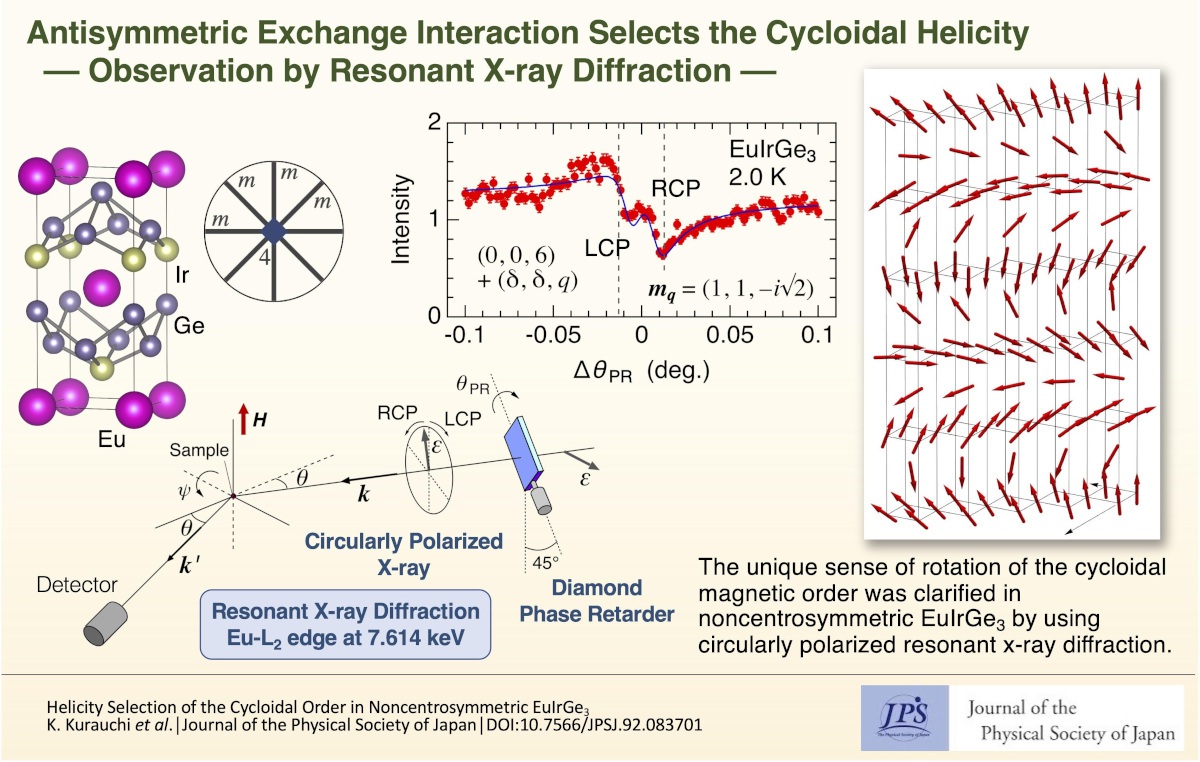Antisymmetric Exchange Interaction Selects the Cycloidal Helicity: Observation by Resonant X-ray Diffraction
© The Physical Society of Japan
This article is on
Helicity Selection of the Cycloidal Order in Noncentrosymmetric EuIrGe3
J. Phys. Soc. Jpn. 92, 083701 (2023).
The unique sense of rotation of the cycloidal magnetic order was clarified in noncentrosymmetric EuIrGe3 by using circularly polarized resonant x-ray diffraction.

In crystals lacking space inversion symmetry, antisymmetric exchange interactions can arise, which are generally expressed in the form of D • (Si x Sj). In normal magnetic ordering by symmetric exchange interactions of the form J Si•Sj, the magnetic moments are aligned parallel or antiparallel to each other into a collinear structure. However, when the antisymmetric exchange is active, the magnetic moments experience a twisting force, resulting in various types of spiral magnetic orderings. The twisting nature of exchange interactions has recently attracted considerable attention because it often generates nontrivial emergent magnetic structures such as chiral soliton lattices and magnetic skyrmion lattices. They are the crystallization of particle-like spin-swirling objects composed of spiral magnetic modulation waves with a single sense of rotation (helicity), which is considered to be the source of topological stability. Therefore, it is important to observe the helicity of the component waves.
The experimental observation of the magnetic helicity is challenging. Although polarized neutron diffraction is a powerful technique, it requires a delicate instrumental setup. In addition, it is unsuitable for samples that contain neutron-absorbing elements such as Eu and Gd. In this study, we employed resonant X-ray diffraction using a synchrotron radiation photon source. We used a diamond phase-retarder system inserted in the incident beam path to manipulate the incident polarization to left- and right-handed circularly polarized states, which have direct sensitivity to the magnetic helicity through different scattering cross-sections for the opposite sense of rotation. We applied a phase-retarder scan to observe the cycloidal ordering in the noncentrosymmetric magnet EuIrGe3, with four mirror reflection planes including the four-fold c-axis.
The cycloidal ordering is characterized by a propagation vector (δ, δ, 0.8), where δ=0.012 at 2.0 K. The Fourier component for this structure is either (1, 1, i √2) or (1, 1, - i √2), where the sign is related to the cycloidal helicity. Furthermore, there arise four magnetic domains described by (δ, δ, 0.8), (-δ, δ, 0.8), (-δ, -δ, 0.8), and (δ, -δ, 0.8). The helicities of all the four domains were measured.
The helicities perfectly reflected the C4v symmetry of the crystal structure. All four Fourier components were related by the 90° rotations and by the mirror reflections. This result clearly shows that the helicity of the cycloid is uniquely selected by the antisymmetric interactions. We believe that this method can be widely applied to the helicity measurements of various types of spiral magnetic systems.
(Written by T. Matsumura on behalf of all the authors.)
Helicity Selection of the Cycloidal Order in Noncentrosymmetric EuIrGe3
J. Phys. Soc. Jpn. 92, 083701 (2023).
Share this topic
Fields
Related Articles
-
Exploring Electronic States in BEDT-TTF Organic Superconductors
Superconductivity
Electronic transport in condensed matter
Magnetic properties in condensed matter
2024-4-24
This review, published in the Journal of the Physical Society of Japan, provides a comprehensive summary of the electronic states observed in BEDT-TTF type organic superconductors, including metal-insulator transitions, Mottness transitions, non-Fermi liquids, quantum spin liquids, and Bose-Einstein condensation.
-
Variety of Mechanically Induced Spin Currents in Rashba Systems
Electronic transport in condensed matter
Magnetic properties in condensed matter
Structure and mechanical and thermal properties in condensed matter
2024-3-22
Various types of spin currents, including unconventional types, are generated in Rashba spin-orbit coupled systems by dynamic lattice distortions associated with, for example, surface acoustic waves.
-
Current Melt Frozen Electrons
Dielectric, optical, and other properties in condensed matter
Magnetic properties in condensed matter
2024-1-15
The origin of the current-induced insulator-to-metal transition of samarium monosulfide was explained by the 4f−5d hybridization observed using optical reflectivity and photoelectron spectroscopies.
-
Towards Uncovering the Hidden Order of URu2Si2 Phase Transition
Magnetic properties in condensed matter
Electronic structure and electrical properties of surfaces and nanostructures
2024-1-11
We propose a chiral charge as the hidden order parameter in URu2Si2 and present experiments to detect it by focusing on breakings of mirror and inversion symmetries at the local uranium ion.
-
Magnetic Excitation in S = 1/2 Antiferromagnetic Chain CsCoCl3 with Ising-Like Exchange Interaction
Magnetic properties in condensed matter
2023-11-13
The results of high-field electron spin resonance measurements in the millimeter-wave to terahertz region reveal unconventional magnetic excitation in S = 1/2 one-dimensional antiferromagnets.
